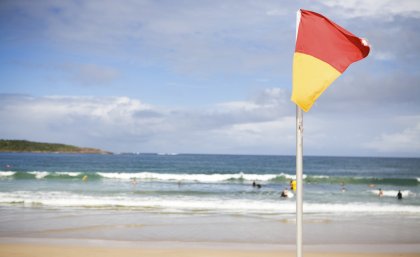
New research shows more powerful communication materials are needed to deter tourists who consistently misjudge their risk of drowning on Queensland’s beaches.
Tourism Associate Professor Brent Ritchie from The University of Queensland Business School said visitors also underestimated the dangers of severe sunburn, rips, stingers and sharks.
“We asked about 900 Gold Coast visitors to assess how likely they were to encounter various hazards,” Professor Ritchie said.
“Without fail, they thought their risk was about 10 per cent lower than a regular beachgoer.”
Professor Ritchie said tourism and lifesaving authorities had done a good job of highlighting the dangers but the research indicated more needed to be done to communicate these to tourists.
“Some tourists are hitting the sand for the first time and many are not native English speakers, so they miss the full impact of the current warning signs,” he said.
“Stronger, more graphic signage and communication materials would help get the message through to tourists who are not used to our weather and coastal conditions – whether that’s regularly applying sunscreen or swimming between the flags.”
Seven people drowned on Queensland’s beaches in the 2013-14 financial year, although no drownings happened between Surf Life Saving Queensland’s red and yellow flags.
More than 70 per cent of coastal drownings were visitors; about a quarter of them from overseas.
“Interestingly, we found tourists were more worried about stingers than getting caught in a rip or drowning,” Professor Ritchie said.
“None of us likes to think that something bad will happen while we’re having fun in the sun but being made aware of the potential dangers means we’re all more likely to take precautions.”
Surf Life Saving Queensland’s Chief Operating Officer George Hill said it was even more important for visitors to be careful at the beach during the winter season.
“So many people come to Queensland in winter to escape the chill elsewhere,” Mr Hill said.
“While professional lifeguard services continue on popular beaches, we do have fewer patrolled beaches during the colder months because our volunteers aren’t on duty again until early September.
“As an organisation which strives for zero preventable deaths in Queensland waters, we support all research that seeks to improve water safety within the community, be it through service delivery, community awareness programs or improved coastal and waterways signage.
“Our existing beach and water safety signage exceeds all current Australian safety standards, however Surf Life Saving Queensland continues to work in close partnership with state government and local councils to explore and implement new safety initiatives.”
The National Picture
In the 2013-14 financial year, there were a total of 84 coastal drownings across Australia. Of these, 33 lived more than 50km from where they drowned and 12 were international visitors.
|
State/Territory |
Deaths by Drowning |
|
New South Wales |
30 |
|
Queensland |
15 |
|
Victoria |
15 |
|
Western Australia |
9 |
|
South Australia |
7 |
|
Northern Territory |
4 |
|
Tasmania |
4 |
NB. This table shows coastal drownings by State or Territory. Coastal drownings are drownings which occur during activities including swimming/wading, boating, rock fishing, etc.
Media: Associate Professor Brent Ritchie, UQ Faculty of Business, Economics and Law, 0413 938 115; b.ritchie@uq.edu.au
.jpg)



